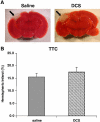D-cycloserine improves functional outcome after traumatic brain injury with wide therapeutic window
- PMID: 19958766
- PMCID: PMC2812686
- DOI: 10.1016/j.ejphar.2009.11.066
D-cycloserine improves functional outcome after traumatic brain injury with wide therapeutic window
Abstract
It has been long thought that hyperactivation of N-methyl-D-aspartate (NMDA) receptors underlies neurological decline after traumatic brain injury. However, all clinical trials with NMDA receptor antagonists failed. Since NMDA receptors are down-regulated from 4h to 2weeks after brain injury, activation at 24h, rather than inhibition, of these receptors, was previously shown to be beneficial in mice. Here, we tested the therapeutic window, dose regimen and mechanism of action of the NMDA receptor partial agonist D-cycloserine (DCS) in traumatic brain injury. Male mice were subjected to trauma using a weight-drop model, and administered 10mg/kg (i.p.) DCS or vehicle once (8, 16, 24, or 72h) twice (24 and 48h) or three times (24, 48 and 72h). Functional recovery was assessed for up to 60days, using a Neurological Severity Score that measures neurobehavioral parameters. In all groups in which treatment was begun at 24 or 72h neurobehavioral function was significantly better than in the vehicle-treated groups. Additional doses, on days 2 and 3 did not further improve recovery. Mice treated at 8h or 16h post injury did not differ from the vehicle-treated controls. Co-administration of the NMDA receptor antagonist MK-801 completely blocked the protective effect of DCS given at 24h. Infarct volume measured by 2,3,5-triphenyltetrazolium chloride staining at 48h or by cresyl violet at 28days was not affected by DCS treatment. Since DCS is used clinically for other indications, the present study offers a novel approach for treating human traumatic brain injury with a therapeutic window of at least 24h.
Copyright (c) 2009 Elsevier B.V. All rights reserved.
Figures





Similar articles
-
D-cycloserine improves functional recovery and reinstates long-term potentiation (LTP) in a mouse model of closed head injury.FASEB J. 2007 Jul;21(9):2033-41. doi: 10.1096/fj.06-7856com. Epub 2007 Mar 9. FASEB J. 2007. PMID: 17351125
-
Novel approach to the role of NMDA receptors in traumatic brain injury.CNS Neurol Disord Drug Targets. 2014;13(4):567-73. doi: 10.2174/18715273113126660196. CNS Neurol Disord Drug Targets. 2014. PMID: 24168367 Review.
-
Effect of the glycine/NMDA receptor partial agonist, D-cycloserine, on seizure threshold and some pharmacodynamic effects of MK-801 in mice.Eur J Pharmacol. 1994 May 23;257(3):217-25. doi: 10.1016/0014-2999(94)90132-5. Eur J Pharmacol. 1994. PMID: 8088343
-
Intrathecally administered D-cycloserine produces nociceptive behavior through the activation of N-methyl-D-aspartate receptor ion-channel complex acting on the glycine recognition site.J Pharmacol Sci. 2007 May;104(1):39-45. doi: 10.1254/jphs.fp0070203. Epub 2007 Apr 24. J Pharmacol Sci. 2007. PMID: 17452810
-
From Mouse to Man: N-Methyl-d-Aspartic Acid Receptor Activation as a Promising Pharmacotherapeutic Strategy for Autism Spectrum Disorders.Med Clin North Am. 2023 Jan;107(1):101-117. doi: 10.1016/j.mcna.2022.05.002. Epub 2022 Oct 28. Med Clin North Am. 2023. PMID: 36402493 Review.
Cited by
-
The cytokine temporal profile in rat cortex after controlled cortical impact.Front Mol Neurosci. 2012 Jan 25;5:6. doi: 10.3389/fnmol.2012.00006. eCollection 2012. Front Mol Neurosci. 2012. PMID: 22291617 Free PMC article.
-
Neuroprotection Trials in Traumatic Brain Injury.Curr Neurol Neurosci Rep. 2016 Apr;16(4):29. doi: 10.1007/s11910-016-0625-x. Curr Neurol Neurosci Rep. 2016. PMID: 26883431 Review.
-
A Systematic Review of Closed Head Injury Models of Mild Traumatic Brain Injury in Mice and Rats.J Neurotrauma. 2019 Jun;36(11):1683-1706. doi: 10.1089/neu.2018.6127. Epub 2019 Mar 6. J Neurotrauma. 2019. PMID: 30661454 Free PMC article.
-
D-Cycloserine Ameliorates Autism-Like Deficits by Removing GluA2-Containing AMPA Receptors in a Valproic Acid-Induced Rat Model.Mol Neurobiol. 2018 Jun;55(6):4811-4824. doi: 10.1007/s12035-017-0685-1. Epub 2017 Jul 21. Mol Neurobiol. 2018. PMID: 28733898
-
Revisiting Excitotoxicity in Traumatic Brain Injury: From Bench to Bedside.Pharmaceutics. 2022 Jan 8;14(1):152. doi: 10.3390/pharmaceutics14010152. Pharmaceutics. 2022. PMID: 35057048 Free PMC article. Review.
References
-
- Alessandri B, Landolt H, Langemann H, Gregorin J, Hall J, Gratzl O. Application of glutamate in the cortex of rats: a microdialysis study. Acta Neurochir Suppl. 1996;67:6–12. - PubMed
-
- Andersen JM, Lindberg V, Myhrer T. Effects of scopolamine and D-cycloserine on non-spatial reference memory in rats. Behav Brain Res. 2002;129:211–216. - PubMed
-
- Baker AJ, Moulton RJ, MacMillan VH, Shedden PM. Excitatory amino acids in cerebrospinal fluid following traumatic brain injury in humans. J Neurosurg. 1993;79:369–372. - PubMed
-
- Barth TM, Grant ML, Schallert T. Effect of MK801 on recovery from sensorimotor cortex lesion. Stroke. 1990;11:153–157. - PubMed
Publication types
MeSH terms
Substances
Grants and funding
LinkOut - more resources
Full Text Sources
Other Literature Sources

